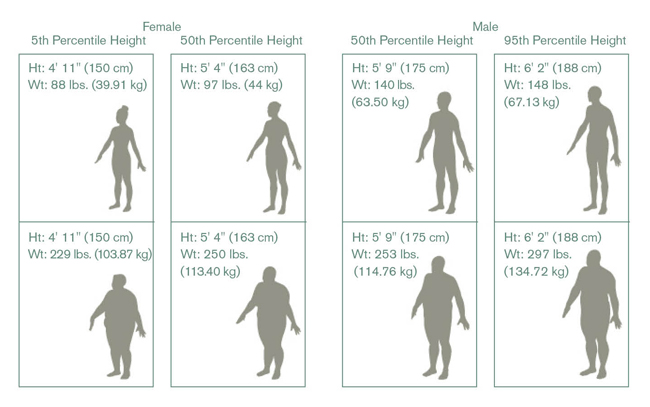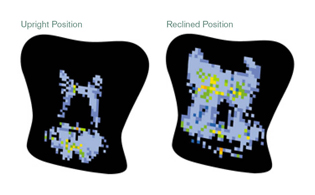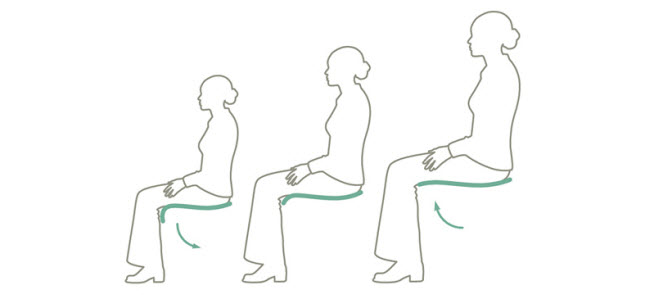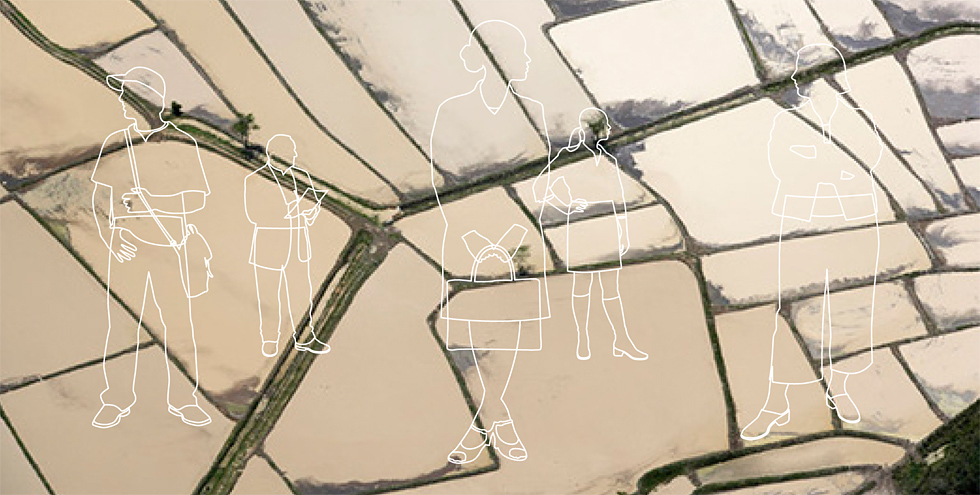The Science and Research Behind the Mirra 2 Chair
A work chair’s geometry should reflect the full range of shapes and sizes of the population. It should not only fit this broad range of sitters, but also be easily fine-tuned to individual work postures and body dimensions by the sitter.
What We Know: Anthropometrics
In the past, one of the authoritative sources for anthropometric (human body dimensional) data was the 1988 U.S. Army Anthropometric Survey (ANSUR) of United States armed forces personnel. This database used conventional linear measurement techniques to record the anatomical dimensions of members of that population. While the test subjects were numerous, they were physically similar. Males were an average weight of 171 pounds (77.56 kg) and average height of 5 feet, 9 inches (175 cm). A 95th percentile male was 6 feet, 1 inch (185 cm) and 216 pounds (97.98 kg); a 5th percentile female was 5 feet (152 cm) and 110 pounds (49.9 kg). The problem with using this data as a basis for applied research in the workplace was that it did not accurately represent the diversity of physical sizes found in today’s civilian office worker population.
NHANES III (The Third National Health and Nutrition Examination Survey) is a survey of civilians that supplements the military data. It uses linear measurement techniques similar to ANSUR, though with a broader test group. In this database, a 95th percentile male is 6 feet, 2 inches (188 cm) and 246 pounds (111.58 kg); a 5th percentile female is 4 feet, 11 inches (150 cm) and 113 pounds (51.26 kg). What these numbers tell us is that there is indeed a significant anthropometric difference between military and civilian databases. To further illustrate: A 95th percentile female in the Army survey is 5 feet, 8 inches (173 cm) tall and 170 pounds (77.11 kg), compared to a 95th percentile female civilian who again is 5 feet, 8 inches tall but 229 pounds (103.87 kg). With increased weight comes increased shape—important to address in our research.
Beginning in the late 1990s, improvements in three-dimensional scanning allowed for more complete human body measurements. Information now includes surface shape data that cannot be measured using conventional instruments. Herman Miller, along with other business partners from industries including transportation and clothing manufacturers, helped to sponsor the first large-scale, three-dimensional survey of any population—military or otherwise. Called CAESAR, which stands for Civilian American and European Surface Anthropometry Resource, it provides a comprehensive and realistic database of anthropometric information.
Our participation in the CAESAR study and subsequent research has helped us address more user profiles and understand more accurately the behavior of the human spine and back when in seated positions. This knowledge gives Herman Miller the ability to design and produce products such as the Mirra 2 chair that truly support the diverse sizes and scales of the human body.
Therefore
A good work chair can correctly and appropriately fit a broad range of sitters’ sizes and proportions. It can be designed to accommodate the varying sizes and proportions of sitters
Design Problem
People of all sizes and shapes adjust to the generalities of everyday objects. The height of countertops, the legroom in cars, the width of airplane seats, the depth of stairs or heights of handrails—all too often these are designed to the average size of the population. Yet when a product is designed to meet the “average,” then average design is often the result.
A typical bell curve tells us that a work chair that serves 95 percent of the population will work very well for those in the middle of that 95 percent and less effectively for those on the ends of that population curve.
Design Solution
The designers of the Mirra 2 chair set out to create a single-sized chair that would meet the size requirements of 95 percent of the population, without compromising anyone in that range. It wouldn’t be a work chair designed to the average, but rather a work chair designed for everyone within that 95 percent.
Mirra 2 presents a single flexible fit design that meets 95 percent of the North American and European adult population without restricting comfort or fit, from a 5th percentile female (4 foot, 11 inch, 113-pound; 150 cm, 51.26 kg) to a 95th percentile male (6 foot, 2 inch, 246-pound; 188 cm, 111.58 kg). / See Figure 1 / It is actually engineered to a 350-pound (158.76 kg) load capacity.

/ Figure 1 / Mirra 2’s flexible fit design meets 95 percent of the North American and European adult population. These selected subjects—among the lightest and heaviest for their given heights—illustrate how peoples’ sizes vary. (CAESAR, 1998-2003)

This degree of adaptability is possible through the design of Mirra 2’s self-contouring suspension seat material and hybrid fabric and polymer backrest, which provide the sitter with custom support and fit. This intelligent support structure, known as the Butterfly Back, also eliminates pressure points for all sizes of bodies. / See Figure 2 / Mirra 2’s Butterfly Back is exceptionally responsive and intuitive. Every part of it has a level of flexibility. There is no spot where the sitter’s back hits a rigid structural component. Further, because the Butterfly Back conforms to the shape of the sitter, any size sitter will find back support where it is needed.
/ Figure 2 / In testing of both large, heavy users and small, light users, no pressure points (which would appear as red dots) are detected against Mirra 2's Butterfly Back, even when users are in reclined positions.
Like Mirra 2’s Butterfly Back, the chair’s elastomeric AireWeave suspension seat is also topographically neutral and responds to the sitter’s individual shape upon contact with the seat. It continues to conform as the sitter’s posture and position on the seat change.
Differences in the size of individual body proportions are also accommodated in Mirra 2 through the chair’s active adjustments. Since the length of the lower leg varies, the height of the seat must vary. Mirra 2’s standard seat height extends from 16 to 20.5 inches (40.64 – 52.07 cm). An optional low height range of 14.75 to 19 inches (37.47 – 48.26 cm) is available, as is an extended option, 16.75 to 22.25 inches (42.55 – 56.52 cm). A substantial height range also helps a sitter adjust more comfortably to nonadjustable office furniture.
A sitter should also be able to comfortably find the seat pocket, formed at the base of the Butterfly Back, whether the sitter has a long or short upper leg length. Mirra 2 achieves this through a revolutionary yet simple idea of curling the front of the seat to adjust the overall depth. While seated, the user can roll the FlexFrontseat front inward or outward up to 2.2 inches (5.6 cm), depending on where the front edge comfortably meets the thighs when the buttocks are settled all the way into the seat. / See Figure 3 /

/ Figure 3 / If the front edge of a chair seat hits the user’s thighs at the wrong spot, it can constrict blood flow and invite muscle pain. A 2.2 inch (5.6 cm) seat depth adjustment accommodates a variety of buttock-popliteal lengths with the ability to fit the depth to the body.
What We Know: User Control
A chair that encourages adjustment, both actively from the sitter and passively through the design of the chair, will more likely be fine-tuned to the individual requirements of that person.
Experts agree that changing seated positions has important benefits for the sitter: Muscle movement aids blood circulation, spine movement nourishes the intervertebral discs, reclining while seated pumps nutrients to the discs, and continuous movement of joints is therapeutic for joints and ligaments. But when a chair requires the sitter to adjust it in order to shift into another position, it may discourage comfortable and supportive movement. Studies of people sitting at work indicate that they tend not to use manual adjustments on their chairs. In fact, according to a Herman Miller study, the majority of users adjust their chairs the first time they use them or not at all (Herman Miller Product Research, 1999).
Therefore
Work chairs need to be able to be fine-tuned to individual work postures and body sizes and, at the same time, to accommodate a range of users without compromising comfort and support.
Work chairs must allow people to sit comfortably and easily make the adjustments that will support their movements and posture changes throughout the day. In other words, a work chair should adjust to its user, not the other way around.
Design Problem
If controls are difficult to use—difficult to find, to activate, or to recognize their effects—they won’t be used. Users are not always properly trained on the how’s and why’s of chair adjustments and, left to their own learning, may avoid making adjustments altogether or make them improperly.
At the same time, work styles and workplace environments have changed. Mobile devices coupled with wireless technology have made dedicated offices irrelevant for many; teams and collaborative work styles keep people moving through facilities and office spaces. Mobile workers have flexibility on one hand, but often limited customization of office furniture, including seating, on the other.
Design Solution
A relationship between a chair and the user can be developed through experience and not instruction, minimizing user effort without compromising the overall support.
We know that sitters seldom make the chair adjustments they should, yet many work chairs continue to become more complex in the variety and number of adjustments offered. Short of a robotic work chair that would tune itself to the sitter, a work chair must help the user easily and intuitively make adjustments.
Passive adjustments are those that do not require activation from the user; in a sense, they are the chair’s default setting. Mirra 2’s seat and backrest provide such passive adjustments. The AireWeave suspension adjusts to the sitter’s buttocks; the Butterfly Back moves and supports the sitter’s back, from the thoracic to the sacral areas of the spine. The backrest and seat continually adjust to the sitter yet require no action on her part.
Active adjustments are those that the user makes to fine-tune the chair to his or her requirements. When researching and designing the adjustment controls for the original Mirra chair, the design team considered user interface first and foremost. The intuitive adjustments of the Mirra 2 leverage the original design of the controls. They are positioned in the “easy reach” zone, which is within the normal drop range of the user’s hands. Adjustments are also shaped to provide clues to the sitter. In particular, the tilt and angle adjustment levers are shaped like the seat and backrest of the Mirra 2 chair—we call it the mini-Mirra. Intuitively, a user moves the mini-Mirra’s “backrest” or “seat” to adjust the actual chair backrest and seat. The tactile quality of the adjustment controls also lend clues to the user. The tilt tension knob, for example, on Mirra 2 is large, soft, and accessible at the side of the chair, making it easy to find, grasp, and turn.
The ability to make adjustments while seated was a mandate of the Mirra 2 design team. The interface between person and chair is instrumental in helping the sitter understand the chair and continue to make adjustments. As an example, with little effort the sitter will notice a difference in just one half of a turn of the tension knob —12 full rotations completes the knob’s range of motion. “Instant feedback” is how the designers describe this adjustment.
The intuitiveness of active adjustments and the simplicity of passive adjustments of the Mirra 2 chair combine to support the sitter’s natural body movements and postures throughout the day.
References
Civilian American and European Surface Anthropometric Resource (CAESAR), 1998 - 2003.
Lowell, Green, and Yuan (2001), “Office Seating Behaviors: An Investigation of Posture, Task, and Job Type,” Proceedings of the Human Factors and Ergonomics Society 45th Annual Meeting.
Herman Miller Product Research Group (1999). “Echocase II,” internal report.
Stumpf, Chadwick, and Dowell (2002). The Kinematics of Sitting.
U.S. Centers for Disease Control and Prevention and The Third National Health and Nutrition Examination Survey (NHANES III), 1988-1994.
Credits
Bill Dowell was Herman Miller’s board-certified Corporate Ergonomist at the time of his death in 2012. During his 28-year career at Herman Miller, Bill was instrumental in leading research into the study of ergonomics and applying the principles of good ergonomic design to our products. In 1991, Bill played a pivotal role in Herman Miller becoming a charter member of the Office Ergonomic Research Committee (OERC). Bill was a key member of the BIFMA Ergonomics Subcommittee that was responsible for the original BIFMA Ergonomic Guideline for VDT Furniture, and was also a member of the committee that revised the BSR/HFES 100 Standard for Human Factors Engineering of Computer Workstations. He was also a member of the CAESAR 3-D surface anthropometric survey and the Human Factors and Ergonomics Society, representing Herman Miller in both groups. Bill’s published work includes studies of seating behaviors, seated anthropometry, the effect of computing on seated posture, the components of subjective comfort, and methods for pressure mapping.
Championing research and creativity in the earliest phases of Herman Miller’s product development efforts, Gretchen Gscheidle leads the team that explores unmet customer needs and responds to strategic questions identified by various organizational leaders. As the research link in all of the company’s seating introductions beginning with the Aeron chair in 1994, Gretchen has a strong record of participation and contribution in product development at Herman Miller. She is a member of the Human Factors and Ergonomics Society and represents Herman Miller on the Office Ergonomics Research Committee. Her research has been published in peer-reviewed journals. Gretchen earned a BFA in Industrial Design from the University of Illinois at Urbana-Champaign and graduated from Northwestern University’s McCormick School of Engineering with a Master’s of Science in Product Design and Development.
Studio 7.5, located in Berlin, Germany, designed the Mirra chair, the Setu chair, and, most recently, Mirra 2—a complete redesign of the original. Designers Burkhard Schmitz, Claudia Plikat, Carola Zwick, and engineer Roland Zwick lead the design firm, which opened in 1992. Also active in education, the designers teach industrial design and product design at universities in Germany. An interest in the tools that define how people work has led Studio 7.5 to design software interfaces, office seating, and medical equipment. Studio 7.5 has been collaborating with Herman Miller for over 20 years.
